In 2022, Thailand is at risk of flooding in some areas. The clear signal comes from 1) oceanographic indices such as the ONI index that reflects the Moderate La Niña[1]), PDO and IOD indices that are in the negative phase or Negative Phase (below -0.5), causing storm volume trends. or the influence of the storm became clearer This indicates that the rainy situation this year will be more than usual. The risky areas are the lower northern region, the upper central region and the northeastern region. Especially in areas that are repeatedly flooded. This may cause damage to economic activity units such as households, factories, machinery and agricultural products. Krungsri Research estimates that the flooded area in 2022 will be 5.3 million rai, causing property damage of approximately 790 million baht. Agriculture was damaged at 11.6 billion baht, representing a loss to GDP of about 0.08 percent.
Warning signs of flooding in 2022
In 2022, Thailand is at risk of flooding. From the weather and environmental factors that signal as follows
- The Oceanic Niño Index (ONI) is an index of surface water temperatures in the equatorial Pacific Ocean[2]. Since August 2020, the ONI index began to indicate La Niña[1]. This means that ocean surface temperatures are likely to fall below normal. As a result, the amount of rain occurs more than usual. The latest data on the index as of April 2022 is -1.1, indicating a moderate La Niña [1]) (Figure 1).
- In 2022, the rainfall in the country is expected to be more than normal[3] by about 3%, approximately 1,635 millimeters, although it is lower than the 2021 level[4] (Figure 2). Increase the amount of water in the dam.
- The volume of water in large dams and medium-sized reservoirs is high. As of the end of May 2022, the total water volume in large dams was 40,045 million cubic meters. representing 56.5 percent of the water capacity in the reservoir This is the highest level in three years and higher than the year 2011 with water volume of 38,132 million cubic meters (55 percent of the capacity volume) (Figure 4). comparable to the year 2011 at 63.9 percent of the capacity
- Storm volume[5] In 2022, the Meteorological Department expects that Thailand will face 2 tropical cyclones, moving through the northeast and northern regions. 3 children per year[6] (Figure 3) and in the past 5 years the average is 2.6 children[7].
- influence of the storm In addition to the main storm Thailand still faces the risk of the influence of storms that, although not directly entering Thailand, may dissipate in neighboring countries or change direction into Thailand. Reflected from relevant oceanographic indices, namely the Pacific Decadal Oscillation (PDO)[8] and the Indian Ocean Dipole (IOD)[9] with negative values of -2.1 (April 2022) and -0.4 (May 2022), respectively. It is expected to continue to be negative until the end of 2022, reflecting the amount of rain that will fall in neighboring countries and enter Thailand more. During the past 5 years, Thailand has been influenced by an average of 5 storms per year[7] ]
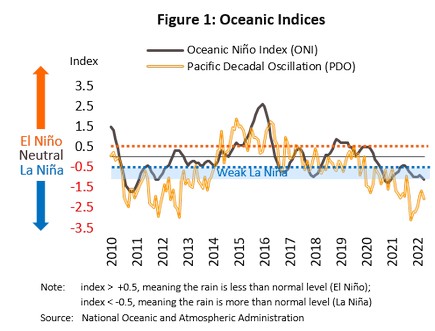
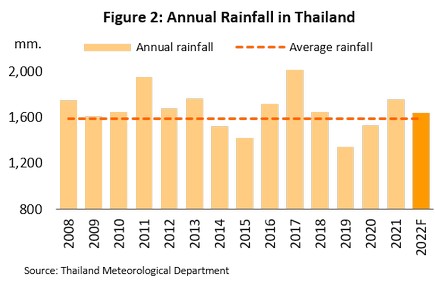
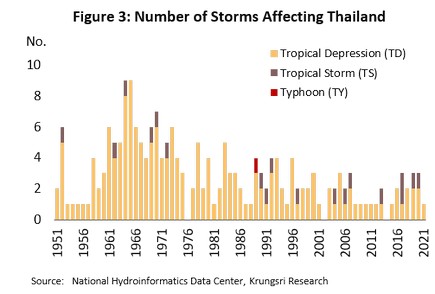
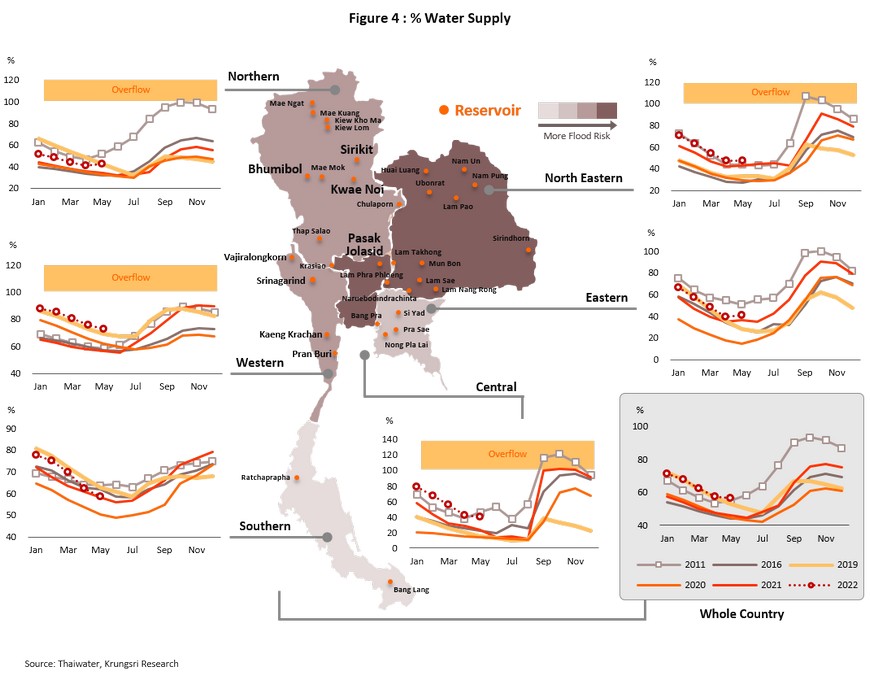
Flood watch area
From the overall picture of the amount of water, it is found that many regions are at risk of flooding. Especially during the months of August to October, when there is a lot of rain (Figure 5) due to the influence of tropical cyclones that are expected to pass through Thailand (Figure 6), which may cause flash floods. flooding Therefore, Krungsri Research has forecast risky areas under various assumptions as follows:
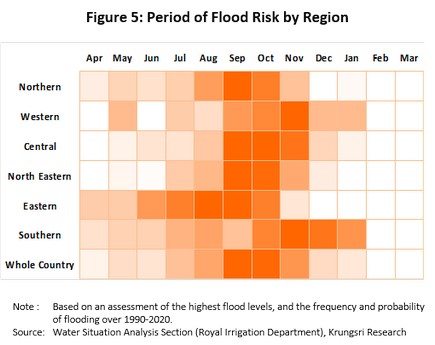
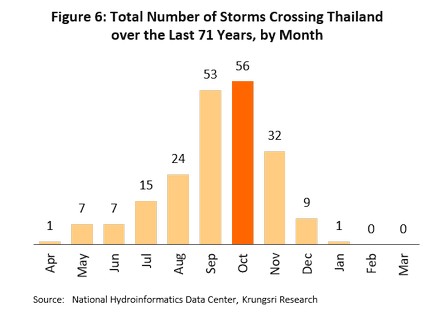
- Northern and Central Regions: High risk of rain under dams Since the water mass in the north will flow from the north to the south (Figure 7), when it converges with rainwater and water mass from the west that is expected to accelerate release [10] (Figure 4), it will cause The amount of water that accumulates in the Chao Phraya River Basin overflows its banks and can cause damage to the economy. Especially in areas that are repeatedly flooded (Figure 8), but if it rains above the dam Flood risk will be reduced in both regions due to the amount of water received by dams in the north at the end of May 2022. Still at only 43 percent [11] of the capacity volume therefore still have the ability to support additional water. However, October is the period to monitor the rainfall in both the northern and central regions that are expected to be 10 percent higher than average and 20 percent higher than average. number
- Northeastern region: There is a high risk in the area of repeated flooding along the Mun River basin[12] because the water volume in the dam is currently at 47.6 percent of the capacity, especially higher than the 2011 level of 43.8 percent. In October, the amount of rain is expected to be 20 percent higher than normal. The drainage in this region will flow from left to right to the Mekong River (Figure 7), making the severity of the flood depending on the water level. in the Mekong If the water level is high, the water can be drained slowly. The damage is more severe and lasts longer than if the water level is low.
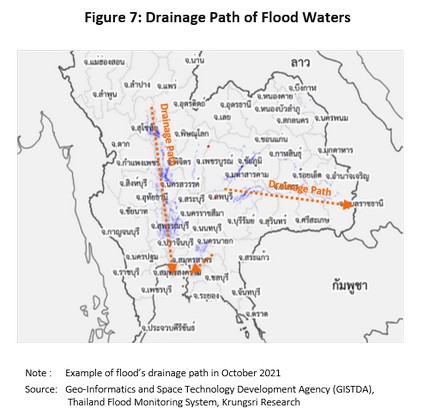
- Southern region: facing risks from both tropical cyclones and the influence of seasonal tropical storms in neighboring countries that cause abundant rainfall during November-December. In October, there is likely to be 5-10 percent more rain than usual, resulting in a risk of flash floods and strong winds. This will cause damage to perennial plants that are the main agricultural crops, including palm and rubber plantations. Including buildings, houses and transportation routes Most of the areas at risk of repeated flooding are located in the south-eastern region (Figure 8).
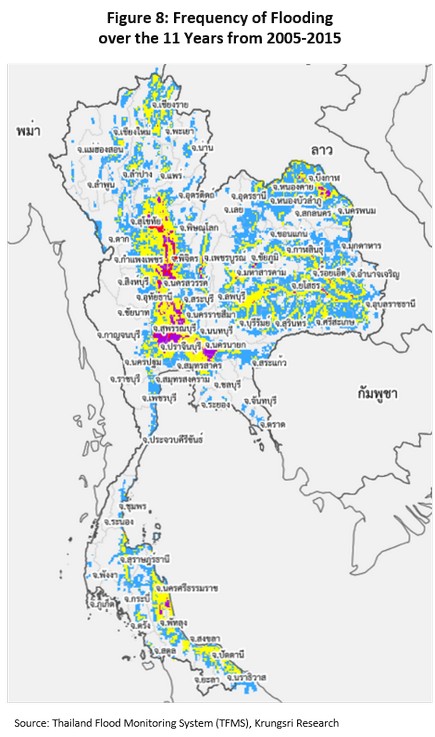
The flood crisis is expected to affect economic units and GDP.
Floods can cause more damage than droughts. Whether it is damage to buildings, houses, factories, machinery, vehicles, transportation routes. and economic animals While the economic crops will be affected by the amount of water and the intensity of the flow through the area. If the level of the flood gradually increases not much and can be drained quickly, it will not cause total damage to some plants. But if the water flow is severe and immersed at a high level for many days, crops such as rice, sugarcane, cassava, including garden and field crops will cause a lot of damage And will affect the supply chain in the production of related industries. Including affecting the price of agricultural products to increase from the problem of supply shortage (Supply shortage).
-
pakgonhttps://pakgon.com/author/pakgon/
-
pakgonhttps://pakgon.com/author/pakgon/
-
pakgonhttps://pakgon.com/author/pakgon/
-
pakgonhttps://pakgon.com/author/pakgon/




